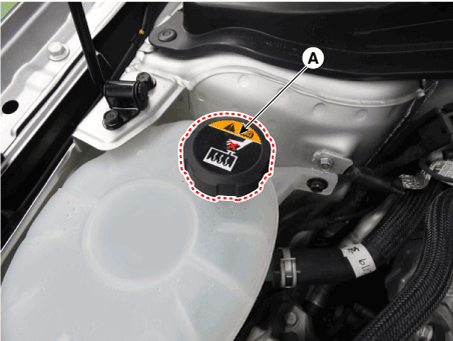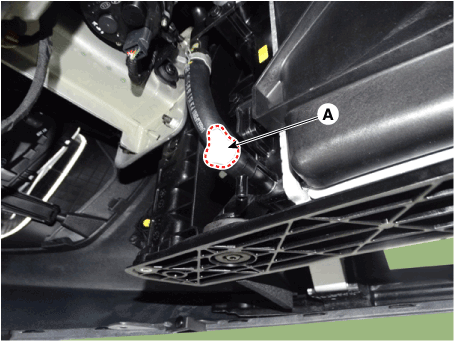Hyundai Ioniq: Cooling System / Coolant. Repair procedures
Hyundai Ioniq (AE) 2017-2025 Service Manual / Engine Mechanical System / Cooling System / Coolant. Repair procedures
| Engine Coolant Refilling and Bleeding |
[Drain]
|
|
| 1. | Make sure the engine and radiator are cool to the touch. |
| 2. | Remove the reservoir tank cap (A).
|
| 3. | Remove the engine room under cover. (Refer to Engine and Transaxle Assembly - "Engine Room Under Cover") |
| 4. | Loosen the drain plug (A), and drain the coolant.
|
| 5. | Tighten the radiator drain plug securely. |
| 6. | After draining engine coolant in the reservoir tank, clean the tank. |
[Filling and Air Bleeding]
| 1. | Fill the radiator with water through the reservoir tank cap and tighten the cap.
|
| 2. | Start the engine and allow to come to normal operating temperature. Wait for the cooling fans to turn on several times. Accelerate the engine to aid in purging trapped air. Shut engine off. |
| 3. | Wait until the engine is cool. |
| 4. | Repeat steps 1 to 3 until the drained water runs clear. |
| 5. | Fill fluid mixture with coolant and water (55-60%) (except for North America, Europe and China : 45-50%) slowly through the reservoir tank cap. Push the upper/lower hoses of the radiator so as bleed air easily.
|
| 6. | Start the engine and run until coolant circulates.When the cooling fan operates and coolant circulates, refill coolant through the reservoir tank cap. |
| 7. | Repeat 6 until the cooling fan 3-5 times and bleed air sufficiently out of the cooling system. |
| 8. | Install the reservoir tank cap and fill the reservoir tank to the "MAX" (or "F") line with coolant. |
| 9. | Run the vehicle under idle until the cooling fan operates 2-3 times. |
| 10. | Stop the engine and wait coolant gets cool.
|
Other information:
Hyundai Ioniq (AE) 2017-2025 Owner's Manual: USB Charger
The USB charger is located inside the console box between the driver's seat and the front passenger's seat. Insert the USB charger into the USB port, and re-charge a smart phone or a tablet PC. A charging status/charging completion message will be displayed on the screen of your device...
Hyundai Ioniq (AE) 2017-2025 Service Manual: Memory power seat unit. Components and components location
C..
Categories
- Manuals Home
- 1st Generation Ioniq Owners Manual
- 1st Generation Ioniq Service Manual
- Checking the Coolant Level
- Folding the side view mirrors
- Immobilizer System
- New on site
- Most important about car
Rear Seats
Folding the rear seat
The rear seatbacks can be folded to facilitate carrying long items or to increase the luggage capacity of the vehicle.
WARNING
Never allow passengers to sit on top of the folded down seatback while the vehicle is moving. This is not a proper seating position and no seat belts are available for use. This could result in serious injury or death in case of an accident or sudden stop. Objects carried on the folded down seatback should not extend higher than the top of the front seatbacks. This could allow cargo to slide forward and cause injury or damage during sudden stops.
Copyright © 2025 www.hioniqae.com







